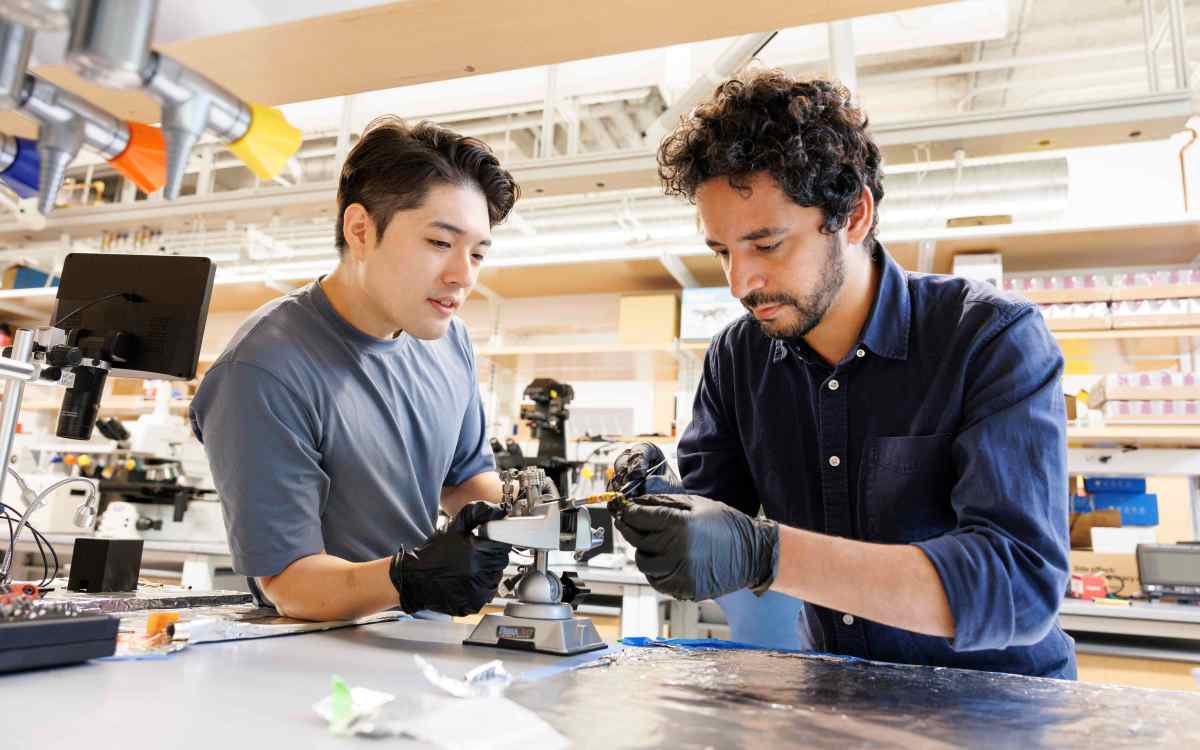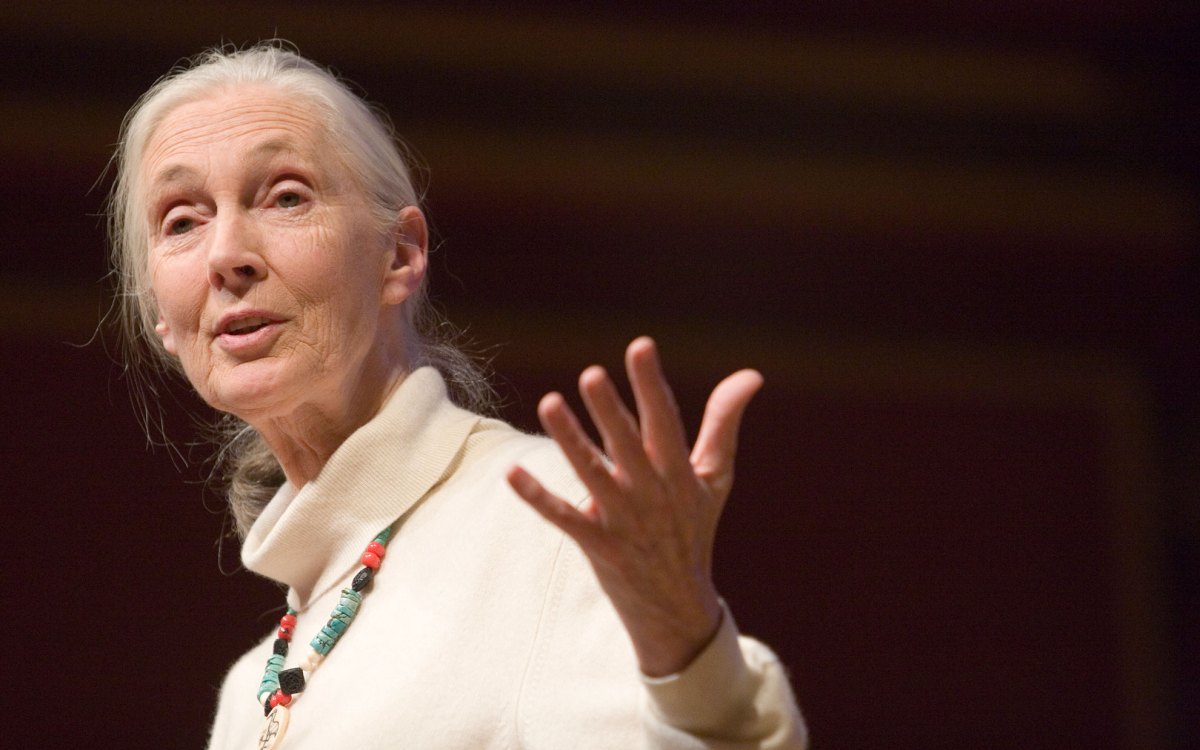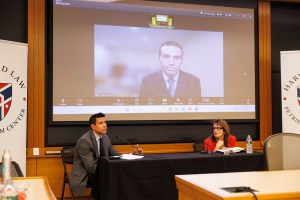Science & Tech
-

Harsh past might bare its teeth
Early adversity leads to higher aggression and fearfulness in adult canines, study says

-

What will AI mean for humanity?
Scholars from range of disciplines see red flags, possibilities ahead
-

‘Human exceptionalism is at the root of the ecological crisis’
Saving the planet requires getting over ourselves, argues author of ‘The Arrogant Ape’
-

Lauren Williams awarded MacArthur ‘genius grant’
Math professor honored for theoretical breakthroughs with sometimes surprising applications across phenomena such as tsunamis, traffic
-

-

‘She had a sense of caring for everybody that she encountered.’
Richard Wrangham remembers his teacher and colleague Jane Goodall as a force of science, empathy, and hope
-
Hauser presents theory of “humaniqueness”
Shedding new light on the great cognitive rift between humans and animals, a Harvard University scientist has synthesized four key differences in human and animal cognition into a hypothesis on…
-
The ethics of the organ bazaar
In nearly every country in the world, there is a shortage of kidneys for transplantation. In the United States, around 73,000 people are on waiting lists to receive a kidney.…
-
Compact, wavelength-on-demand Quantum Cascade Laser chip created
Engineers at Harvard’s School of Engineering and Applied Sciences have demonstrated a highly versatile, compact and portable Quantum Cascade Laser sensor for the fast detection of a large number of…
-
HarvardScience website wins top awards in two categories
The Interactive Media Council has named the HarvardScience website “Best in Class” in both the medicine and science categories of its annual Interactive Media Awards competition. In notifying HarvardScience of…
-
Scientists may have identified new target for HIV vaccine
By coaxing the HIV-1 protein to reveal a hidden portion of its protein coat, scientists at Dana-Farber Cancer Institute and Harvard Medical School have provided a newly detailed picture of…
-
E. O. Wilson receives Linean Society Tercentenary Medal
The Linnean Society of London has awarded Edward O. Wilson, Pelegrino University Research Professor, Emeritus, one of three specially-commissioned Tercentenary Medals to honor his outstanding contribution to the world’s understanding…
-
Neuroimaging fails to demonstrate ESP is real
Psychologists at Harvard University have developed a new method to study extrasensory perception that, they argue, can resolve the century-old debate over its existence. According to the authors, their study…
-
Turning on cells with magnetic switches
Harvard scientists have figured out how to turn cells on and off using magnets, an advance with potentially broad applications as researchers around the world work to find new ways…
-
Sulfur dioxide may have helped maintain a warm early Mars
Sulfur dioxide (SO2) may have played a key role in the climate and geochemistry of early Mars, geoscientists at Harvard University and the Massachusetts Institute of Technology (MIT) suggest in…
-
Living in disadvantaged neighborhood equivalent to missing a year of school
Childhood exposure to severely disadvantaged communities is linked to decreased verbal ability later in childhood, a lasting negative effect that continues even after moving out of the neighborhood, according to…
-
Discovery of a key molecular switch regulating cancer stem cells
The role of stem cells in tumor development has, unexpectedly, been one of the biggest stories in cancer research over the past few years. These aren’t embryonic stem cells, but…
-
Chimps in wild appear not to regularly experience menopause
A pioneering study of wild chimpanzees has found that these close human relatives do not routinely experience menopause, rebutting previous studies of captive individuals which had postulated that female chimpanzees…
-
Female lower back has evolved to accommodate strain of pregnancy
According to a new study by researchers at Harvard and the University of Texas at Austin, women’s lower spines evolved to be more flexible and supportive than men’s to increase…
-
Trafficked
Slight and soft-spoken, the dark-eyed girl called Gina looks into the camera and speaks of her ordeal in a flat, disembodied voice, chronicling a story relived a thousand times. “The…
-
From neuroscience to childhood policy
The Center on the Developing Child, founded in July 2006 to promote healthy child development as “the foundation of community development, economic prosperity, and a secure nation,” has been putting…
-
Seabed microbe study leads to low-cost power, light for the poor
A Harvard biology professor’s fascination with seafloor microbes has led to the development of a revolutionary, low-cost power system consuming garbage, compost, and other waste that could provide light for the developing world.
-
Gonzalo Giribet
They had sifted through the forest floor’s leaves and dirt for days, looking for a tiny type of daddy longlegs native to New Zealand, but had little more than dirty…
-
White dwarf ‘sibling rivalry’ explodes into supernova
Astronomers at the Harvard-Smithsonian Center for Astrophysics (CfA) have found that a supernova discovered last year was caused by two colliding white dwarf stars.
-
Holdren talks back to skeptics of global warming
“Global warming is a misnomer,” said John P. Holdren, speaking Tuesday night (Nov. 6) at the John F. Kennedy Jr. Forum at the Kennedy School. “It implies something gradual, uniform, and benign. What we’re experiencing is none of these.”
-
Engineered weathering process could mitigate global warming
Researchers at Harvard University and Pennsylvania State University have invented a technology, inspired by nature, to reduce the accumulation of atmospheric carbon dioxide (CO2) caused by human emissions.
-
The cultural politics of pain, from Percodan to Kevorkian
On a rainy Tuesday afternoon, physicians, historians of science, and members of the general public gathered in the Gymnasium at the Radcliffe Institute for Advanced Study to hear about pain.…
-
Engineered weathering process might mitigate climate change
Researchers at Harvard University and Penn State University have invented a technology, inspired by nature, to reduce the accumulation of atmospheric carbon dioxide (CO2) caused by human emissions. By electrochemically…
-
Foraging for forest frogs
In the dark of the Sri Lankan cloud forest, the researchers’ only guides were the headlamps they used to light up the night, illuminating the cold, gray mist that drifted…
-
Harvard, Japanese science organization sign memorandum of understanding
Officials of Harvard and RIKEN, Japan’s equivalent of the U.S. Department of Energy’s National Lanoratories have October 29 signed a Memorandum of Understanding to encourage and facilitate collaborations between Harvard…
-
Percentage of Katrina survivors with mental disorders increasing
According to the most comprehensive survey yet conducted of people affected by Hurricane Katrina, the percentage of pre-hurricane residents of the affected areas in Alabama, Louisiana, and Mississippi who have…
-
New laser nanoantenna shows unprecedented detail
In a stunning feat of nanotechnology engineering, researchers from Harvard University have demonstrated a laser with a wide-range of potential applications in chemistry, biology, and medicine. Called a quantum cascade (QC) laser antenna, the device is capable of resolving the chemical composition of samples, such as the interior of a cell, with unprecedented detail.
-
Massive black hole smashes record for sizeMassive black hole smashes record for size
Using two NASA satellites, astronomers have discovered a black hole that obliterates a record announced just two weeks ago. The new black hole, with a mass 24 to 33 times that of our sun, is the heftiest known black hole to orbit another star.
-
If not in atmosphere, where does carbon go?
A prominent atmospheric scientist Monday (Oct. 29) called for more research into natural carbon “sinks,” which today absorb almost half of man-made carbon dioxide released into the atmosphere and which will play a large role in determining the extent of future global warming.
-
White dwarf “sibling rivalry” explodes
The new find, supernova 2006gz, was classified as a Type Ia due to the lack of hydrogen and other characteristics. However, an analysis combining CfA data with measurements from The Ohio State University suggested that SN 2006gz was unusual and deserved a closer look.
-
Survey: Med students ill prepared for ethical issues faced in wartime
A new survey of U.S. medical students shows they receive little training about what they should or should not do in wartime, despite ethical questions over physician involvement in prisoner…


